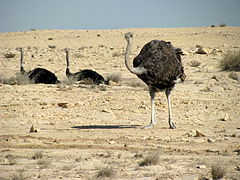|
Ras Abrouq
Ras Abrouq (Arabic: رأس أبروق; also known as Bir Zekreet)[2] is the northernmost extension of the Zekreet Peninsula, a stretch of land to the north of Dukhan in Qatar.[3] It has a beach of the same name[2] and various archaeological sites. Since the 21st century it has functioned as a tourist site.[2] Large parts of its territory are legally protected as a nature reserve for wild deer.[4] Richard Serra's East-West/West-East sculpture was completed in Brouq Nature Reserve in 2014 at the behest of the Qatar Museums Authority.[5] EtymologyThe Arabic word "ras" translates to "head", and in this context is used to refer to a cape. The other constituent, "abrouq", is derived from the nearby range of light-colored hills in the Zekreet Peninsula (also known as the Abrouq Peninsula).[3] Its name is also spelled as Ras Broog.[3] GeographyRas Abrouq is a cape on the tip of the Zekreet Peninsula near the city of Dukhan in western Qatar. It is 70 km (43 mi) west of the capital Doha.[6] It overlooks the Dawakhil Islands to the north, serving as a significant coastal landmark.[7] The village of Zekreet is located south of Ras Abrouq.[3] Geographically, it forms the northernmost point of the Dukhan region. The coastal area is relatively narrow, measuring about 3 km (1.9 mi) in width, in contrast to the wider sections of the Dukhan region further south.[7] ArchaeologyRas Abrouq is one of the most extensive Neolithic sites in Qatar. It has one of the highest proportions of Ubaid potsherds in Qatar.[8] Excavations in the 1970s revealed a ring-like structure, hearths, Ubaid pottery, cairns, and stone tools dating to the Neolithic period. Many fish bones and snail shells were also recovered.[9] G.H. Smith, an excavator of the site, suggested that it was a seasonal encampment and that its inhabitants had trade relations with nearby civilizations.[9][10] Further archaeological excavations yielded Barbar ceramics originating from the Dilmun civilization dating to the third millennium BC.[11] A number of chambered cairns dating to the same period contained 108 beads made of stone and shell.[12] Excavations conducted during the mid-20th century uncovered potsherds with Seleucid characteristic and a cairnfield consisting of 100 burial mounds dating to the 3rd century BC.[13][14] The relatively large number of cairns suggest a sizable sea-faring community prevailed in the area during this period.[15] Further excavations revealed a fishing station dating to c. 140 BC which was used by foreign vessels to dry fish during the Sasanian period.[16] A number of stone structures and large quantities of fish bones were recovered from the site.[15] Gallery
References
|
||||||||||||||||||||||




